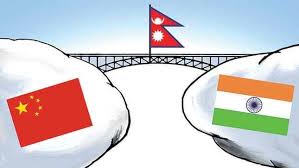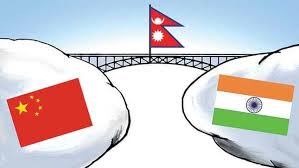Nepal is not just another neighbor to India and China. After China’s annexation of Tibet in 1951, Nepal has been acting as a buffer state between the two countries. India-Nepal relations can be traced back to 1950s when both the countries signed the Peace and Friendship Treaty with each other, under which Nepal allowed access to weaponry from India, both countries agreed on open borders through which citizens in both the countries can move easily. They also signed the Treaty of Trade and Commerce in 1950 which strengthened their trade ties by streamlining customs and duties regulations between the two countries. India used to be Nepal’s largest foreign investor in Nepal, providing aid, helping in improving infrastructure post the earthquake, constructing hydro-power projects jointly etc. The relations between India and Nepal deteriorated after the Madhesi crisis took place in Nepal. The formation of new constitution and the election of leftist government backed by China, in Nepal further strained the relations between the countries. The economic blockade in 2015 was the final step that pushed Nepal directly into the arms of China
Nepal’s relation with China has seen a very rocky ride due to the Tibet war and Nepal-China border conflicts post the annexation of Tibet by China. However, Nepal also signed a Peace and Friendship Treaty with China in 1960 which marked the recognition of Tibet as a part of China by Nepal. Since then China has constantly supported every move taken by Nepal. As time passes we can see Nepal inclining towards China due to the leftist government. Nepal has also joined China’s belt and road initiative which has become a major concern for India. In the past, Nepal without doubt favored India, but since the formation of new government and new constitution Nepal is playing a balancing act by building trade, infrastructure, economic and social ties with China as well.
 Recently, Nepal government asked its National Defense force i.e. the Nepal Army to withdraw from the first Bay of Bengal Initiative for Multi-Sectoral Technical and Economic Co-operation (BIMSTEC) military drill taking place in India. BIMSTEC is a regional grouping comprising of Bangladesh, Bhutan, India, Myanmar, Nepal, Sri-Lanka and Thailand. The biggest takeaways from this grouping are security and connectivity in South Asian and South East Asian countries. This is yet another setback in India-Nepal relations and also comes at a time when Nepal-China relations are on an upward trajectory.
Recently, Nepal government asked its National Defense force i.e. the Nepal Army to withdraw from the first Bay of Bengal Initiative for Multi-Sectoral Technical and Economic Co-operation (BIMSTEC) military drill taking place in India. BIMSTEC is a regional grouping comprising of Bangladesh, Bhutan, India, Myanmar, Nepal, Sri-Lanka and Thailand. The biggest takeaways from this grouping are security and connectivity in South Asian and South East Asian countries. This is yet another setback in India-Nepal relations and also comes at a time when Nepal-China relations are on an upward trajectory.
The Nepal Government understands the geopolitical advantage it has due to its geographical location but China’s interest and proven ability in aiding Nepal which is also boosting Nepal’s economy against India’s limited capacity is pushing Nepal towards China. They say that Nepal needs to maintain a balance between the two but Nepal seeking balance between distant China and next-door India with which it has had open borders and centuries long cultural, economic, political and military bonds, is itself a sign of how the power balance is shifting towards China in South Asia.
In my opinion India is losing its neighbors one by one to China. Pakistan is already aligned with China economically, China has also started increasing its power in Sri Lanka by constructing Chinese ports on Sri Lankan land and creating its base in the Indian Ocean and now it is giving access of China’s port in the south to Nepal in order to make Nepal join the Belt and Road Initiative. China is providing huge infrastructure projects to Pakistan, Nepal, Sri Lanka and Myanmar which turns into liabilities by increasing their debts and provides China with a financial leverage for a long time over these countries. China is a threat to India. However, the recent Dokhalam standoff proves that India will not let the 1962 war repeat itself. India has been making its defense stronger by signing various deals. For China, Nepal is a gateway to North East India. To maintain strong relations with Nepal, India first needs to fulfill the promises it has made to Nepal in the past like the hydro-power project and dam which are incomplete since a long time, this on one hand makes Nepal question India’s credibility and on the other hand increases its will to take aid from China who has completed the projects on time. This show that Nepal goes by the view of first come, first served principle. It must focus on easy connectivity as a leverage to increase its strategic influence. Also, India should increase its bilateral talks and communications with Nepal. If India does not take necessary steps towards Nepal, it might lose its most important and oldest neighbor to China.

Leave a comment